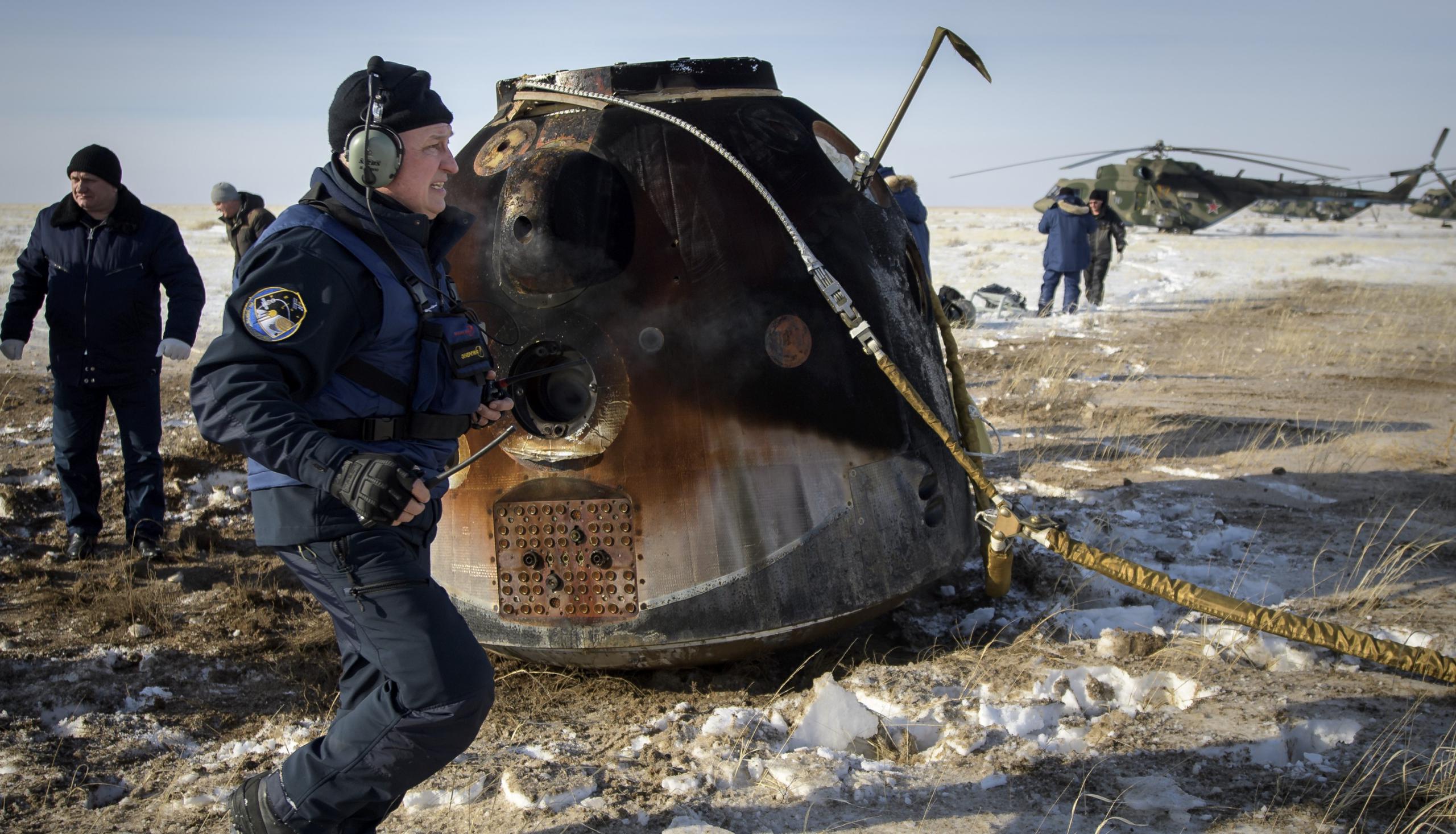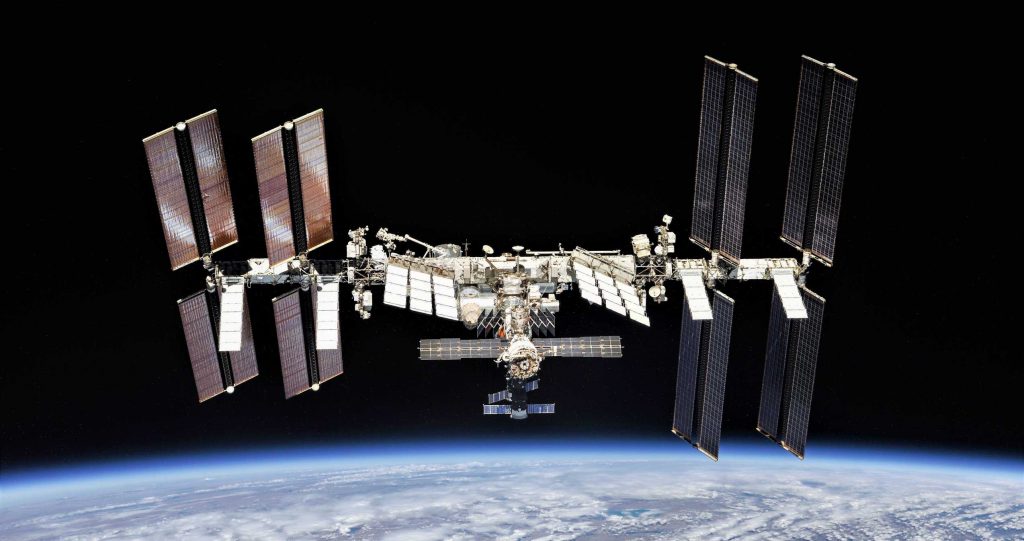

News
NASA says “nothing has changed” as US astronaut prepares to ride Russian spacecraft
An official Russian video posted on Twitter has fueled rampant speculation that the country’s beleaguered space agency intends to abandon NASA astronaut Mark Vande Hei on the International Space Station.
On March 5th, a Russian state news outlet “RIA Novosti” shared a video on Twitter that depicted Mark Vande Hei being left on the Internation Space Station, rather than departing on board the Russian Soyuz spacecraft as planned. The video was just the latest example of growing tension between Russia and the rest of the world as sanctions for the illegal invasion of Ukraine and some of the country’s own responses to those sanctions have rapidly severed many of its ties to the international space industry. So far, Russia has terminated commercial Soyuz launch operations at the European Space Agency’s launch site in Kourou, French Guiana, effectively stolen several rockets already purchased by satellite internet company OneWeb, and cut-off sales and support for Russian rocket engines used in two US rockets.
As a result, the future of the International Space Station (ISS) has never felt less certain. In recent days, these concerns have grown exponentially as many news outlets began to report on purported concerns that Vande Hei would be abandoned on the ISS.
Dmitry Rogozin, the director-general of the Russian federal space agency Roscosmos, has also been posting a number of increasingly chaotic tweets claiming that Western sanctions will “destroy their International Space Station partnership” and making threats about potential catastrophes that could unfold on the ISS without Russian contributions.
Despite these claims, NASA has reassured the public that “operations have not changed at all”.
Vande Hei is scheduled to depart from the ISS later this month aboard a Russian Soyuz spacecraft with cosmonauts Anton Shkaplerov and Petr Dubrov, ultimately touching down in Kazakhstan. However, even if Russia were to decide to leave Van Hei aboard the space station, he would not be “stranded”. Three American astronauts – Raja Chari, Kayla Barron, and Thomas Marshburn remain aboard the ISS along with German ESA astronaut Matthias Maurer. Additionally, thanks entirely to SpaceX, NASA has its own domestic transportation to and from the ISS in the form of Crew Dragon. In theory, it’s possible that NASA’s current ISS crew could somehow modify Crew Dragon to return five – not four – astronauts to Earth, allowing Vande Hei to extract himself from a tense political conundrum.
However, that may not be possible in such a short time frame, as SpaceX would need to find a way to add a fifth seat to Dragon and figure out how to accommodate Vande Hei’s Russian spacesuit. That work could easily take weeks or months to safely complete, potentially forcing Mark to stay in space for at least another half a year to return to Earth with Crew-4 instead of Crew-3. Even then, Crew-4 is scheduled to launch just one month from now, so even that alternative may not be a viable.


Regardless, given the unprovoked, irrational, and increasingly brutal nature of Russia’s second invasion of Ukraine, Russia’s international spaceflight partnerships have never been more unstable. While unlikely, it’s possible that Rogozin or Putin himself could choose to end the ISS partnership altogether, though there is a great deal of ambiguity as to whether either ISS ‘segment’ could survive on its own. Thankfully, NASA has partial alternatives to some of the services the Russian ISS segment has provided. Northrup Grumman’s Cygnus spacecraft intends to perform the first Western ISS reboost maneuver later this year. Russia has been almost exclusively responsible for ISS reboosting and maneuvering over the two-decade life of the station.
Meanwhile, in spite of the circumstances, Vande Hei is still on track to break the American record for the longest continuous stay in space, beating out NASA astronaut Scott Kelly’s 340-day streak by about two weeks. NASA associate space operations administrator Kathy Lueders stated in a press conference that NASA “[is] getting ready for Mark to return, and all of the normal operations are in place for that for us to be able to do that”.
Once on the ground in Kazakhstan, Vande Hei will be met by a team of NASA personnel tasked with bringing the astronaut back to Houston, Texas. He will then start the recovery process after living in microgravity for almost a full year.
News
Tesla begins Robotaxi certification push in Arizona: report
Tesla seems serious about expanding its Robotaxi service to several states in the coming months.

Tesla has initiated discussions with Arizona transportation regulators to certify its driverless Robotaxi service in the state, as per a recent report from Bloomberg News. The move follows Tesla’s launch of its Robotaxi pilot program in Austin, Texas, as well as CEO Elon Musk’s recent comments about the service’s expansion in the Bay Area.
The Arizona Department of Transportation confirmed to Bloomberg that Tesla has reached out to begin the certification process for autonomous ride-sharing operations in the state. While details remain limited, the outreach suggests that Tesla is serious about expanding its driverless Robotaxi service to several territories in the coming months.
The Arizona development comes as Tesla prepares to expand its service area in Austin this weekend, as per CEO Elon Musk in a post on X. Musk also stated that Tesla is targeting the San Francisco Bay Area as its next major market, with a potential launch “in a month or two,” pending regulatory approvals.
Tesla first launched its autonomous ride-hailing program on June 22 in Austin with a small fleet of Model Y vehicles, accompanied by a Tesla employee in the passenger seat to monitor safety. While still classified as a test, Musk has said the program will expand to about 1,000 vehicles in the coming months. Tesla will later upgrade its Robotaxi fleet with the Cyercab, a two-seater that is designed without a steering wheel.
Sightings of Cybercab castings around the Giga Texas complex suggests that Tesla may be ramping the initial trial production of the self-driving two-seater. Tesla, for its part, has noted in the past that volume production of the Cybercab is expected to start sometime next year.
In California, Tesla has already applied for a transportation charter-party carrier permit from the state’s Public Utilities Commission. The company is reportedly taking a phased approach to operating in California, with the Robotaxi service starting with pre-arranged rides for employees in vehicles with safety drivers.
News
Tesla sets November 6 date for 2025 Annual Shareholder Meeting
The automaker announced the date on Thursday in a Form 8-K.

Tesla has scheduled its 2025 annual shareholder meeting for November 6, addressing investor concerns that the company was nearing a legal deadline to hold the event.
The automaker announced the date on Thursday in a Form 8-K submitted to the United States Securities and Exchange Commission (SEC). The company also listed a new proposal submission deadline of July 31 for items to be included in the proxy statement.
Tesla’s announcement followed calls from a group of 27 shareholders, including the leaders of large public pension funds, which urged Tesla’s board to formally set the meeting date, as noted in a report from The Wall Street Journal.
The group noted that under Texas law, where Tesla is now incorporated, companies must hold annual meetings within 13 months of the last one if requested by shareholders. Tesla’s previous annual shareholder meeting was held on June 13, 2024, which placed the July 13 deadline in focus.
Tesla originally stated in its 2024 annual report that it would file its proxy statement by the end of April. However, an amended filing on April 30 indicated that the Board of Directors had not yet finalized a meeting date, at least at the time.
The April filing also confirmed that Tesla’s board had formed a special committee to evaluate certain matters related to CEO Elon Musk’s compensation plan. Musk’s CEO performance award remains at the center of a lengthy legal dispute in Delaware, Tesla’s former state of incorporation.
Due to the aftermath of Musk’s legal dispute about his compensation plan in Delaware, he has not been paid for his work at Tesla for several years. Musk, for his part, has noted that he is more concerned about his voting stake in Tesla than his actual salary.
At last year’s annual meeting, TSLA shareholders voted to reapprove Elon Musk’s compensation plan and ratified Tesla’s decision to relocate its legal domicile from Delaware to Texas.
Elon Musk
Grok coming to Tesla vehicles next week “at the latest:” Elon Musk
Grok’s rollout to Tesla vehicles is expected to begin next week at the latest.

Elon Musk announced on Thursday that Grok, the large language model developed by his startup xAI, will soon be available in Tesla vehicles. Grok’s rollout to Tesla vehicles is expected to begin next week at the latest, further deepening the ties between the two Elon Musk-led companies.
Tesla–xAI synergy
Musk confirmed the news on X shortly after livestreaming the release of Grok 4, xAI’s latest large language model. “Grok is coming to Tesla vehicles very soon. Next week at the latest,” Musk wrote in a post on social media platform X.
During the livestream, Musk and several members of the xAI team highlighted several upgrades to Grok 4’s voice capabilities and performance metrics, positioning the LLM as competitive with top-tier models from OpenAI and Google.
The in-vehicle integration of Grok marks a new chapter in Tesla’s AI development. While Tesla has long relied on in-house systems for autonomous driving and energy optimization, Grok’s integration would introduce conversational AI directly into its vehicles’ user experience. This integration could potentially improve customer interaction inside Tesla vehicles.
xAI and Tesla’s collaborative footprint
Grok’s upcoming rollout to Tesla vehicles adds to a growing business relationship between Tesla and xAI. Earlier this year, Tesla disclosed that it generated $198.3 million in revenue from commercial, consulting, and support agreements with xAI, as noted in a report from Bloomberg News. A large portion of that amount, however, came from the sale of Megapack energy storage systems to the artificial intelligence startup.
In July 2023, Musk polled X users about whether Tesla should invest $5 billion in xAI. While no formal investment has been made so far, 68% of poll participants voted yes, and Musk has since stated that the idea would be discussed with Tesla’s board.
-

 Elon Musk1 week ago
Elon Musk1 week agoTesla investors will be shocked by Jim Cramer’s latest assessment
-

 Elon Musk3 days ago
Elon Musk3 days agoElon Musk confirms Grok 4 launch on July 9 with livestream event
-

 Elon Musk16 hours ago
Elon Musk16 hours agoxAI launches Grok 4 with new $300/month SuperGrok Heavy subscription
-

 News7 days ago
News7 days agoTesla Model 3 ranks as the safest new car in Europe for 2025, per Euro NCAP tests
-

 Elon Musk2 weeks ago
Elon Musk2 weeks agoA Tesla just delivered itself to a customer autonomously, Elon Musk confirms
-

 Elon Musk1 week ago
Elon Musk1 week agoxAI’s Memphis data center receives air permit despite community criticism
-

 Elon Musk2 weeks ago
Elon Musk2 weeks agoTesla’s Omead Afshar, known as Elon Musk’s right-hand man, leaves company: reports
-

 News2 weeks ago
News2 weeks agoXiaomi CEO congratulates Tesla on first FSD delivery: “We have to continue learning!”

















